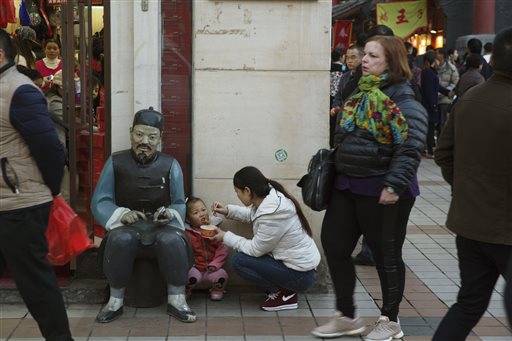China will allow all couples to have two children, abandoning its decades-long one-child limit, the Communist Party of China (CPC) announced after a key meeting on Thursday.

FILE – In this Wednesday, Oct. 31, 2012, file photo, a Chinese woman plays with her grandchild at the Ritan Park in Beijing. (AP Photo/Andy Wong)
The change of policy is intended to balance population development and address the challenge of an aging population, according to a communique issued after the Fifth Plenary Session of the 18th Communist Party of China (CPC) Central Committee held from Monday to Thursday.
The proposal must be approved by the top legislature before it is enacted.
China’s family planning policy was first introduced in the late 1970s to rein in the surging population by limiting most urban couples to one child and most rural couples to two children, if the first child born was a girl. The policy was later relaxed to say that any parents could have a second child if they were both only children.
The one-child policy was further loosened in November 2013 after the Third Plenary Session of the 18th CPC Central Committee, with its current form stipulating that couples are allowed to have two children if one of them is an only child.
100 million couples would be eligible under a universal two-child policy

A woman feeds a child in Beijing, China, Thursday, Oct. 29, 2015. (AP Photo/Ng Han Guan)
About 100 million Chinese couples will be eligible to have a second child when Beijing further relaxes the national one-child birth rule, a top Chinese population scientist estimated.
Yuan Xin, a scientist at Nankai University in Tianjin who sits on an expert panel of the National Health and Family Planning Commission, offered the projection in an interview with China Daily.
As of June, only 1.5 million of the 11 million eligible couples had applied for second child.
The change will have a greater impact on rural families who are more interested than urbanites in having bigger families, Yuan said.
“The coming universal two-child policy would be much better received among the people than the previous policy relaxation,” he said.
Yuan also urged the addition of more favorable social and economic policies to make it easier for couples to raise more children.

FILE – In this Monday, March 17, 2014, file photo, a man pushes a baby buggy near a construction site of a residential real estate project in a village on the outskirts of Beijing. (AP Photo/Alexander F. Yuan, File)
Official statistics show that China’s potential workforce, people ages 16 to 59, peaked around 2011, and has been in decline since then. At the same time, the number of working people has been declining as a proportion of the total population.
Last year, there were 916 million people between the ages of 16 and 59 in China, roughly 66 percent of the entire population. The proportion hit a peak of 74.5 percent in 2010, and has been falling ever since.
At the same time, the percentage of children to the total population has been dwindling, creating a dearth of future workers, said Mu Guangzong, a demographics expert at Peking University.
“The looming labor shortage will upset sustainable socioeconomic development of the country,” Mu said.
To reverse the trend and fuel population growth, he recommended ending limits on family size.
China will need a new baby boom to counter aging, low fertility and labor shortages, Mu said.
Story by China Daily
One-child policy first introduced in China to control population
The one-child policy dates back to 1979. Its aim was to stabilize China’s booming population. So has it worked? CCTV’s Roee Ruttenberg reports.

Follow Roee Ruttenberg on Twitter @RoeeRuttenberg
Zhao Yunjie on China allowing two children for all couples
For more on China’s end to the one-child policy after 35 years, CCTV America spoke with CCTV’s Zhao Yunjie.

Victor Gao and Haiyan Wang on the two child decision
For more on China’s landmark decision to end its one-child policy, CCTV America’s Asieh Namdar spoke to Haiyan Wang. She’s a managing partner at the China India Institute here in Washington. Joining the panel was also Victor Gao, a current affairs commentator.

Dali Yang on the impact of the one-child policy on population
CCTV America interviewed Dali Yang for more on China ends one-child policy after 35 years. He is a Political Science Professor at the University of Chicago.

Einar Tangen on Economic impact of the one-child policy changes
The plan may have been finalized but it still has to be approved by the National People’s Congress in early 2016.
For more on what the blueprint means for China’s economy and society, CCTV America interviewed Einar Tangen. He’s a current affairs commentator.

 CGTN America
CGTN America FILE – In this Tuesday March 19, 2013, file photo, an elderly Chinese woman caries a baby in a traditional basket on the outskirts of Chongqing, China. China announced on Oct. 29, 2015, that it will abolish the country’s decades-old one-child policy and allow all couples to have two children. (AP Photo/Eugene Hoshiko, File)
FILE – In this Tuesday March 19, 2013, file photo, an elderly Chinese woman caries a baby in a traditional basket on the outskirts of Chongqing, China. China announced on Oct. 29, 2015, that it will abolish the country’s decades-old one-child policy and allow all couples to have two children. (AP Photo/Eugene Hoshiko, File)
